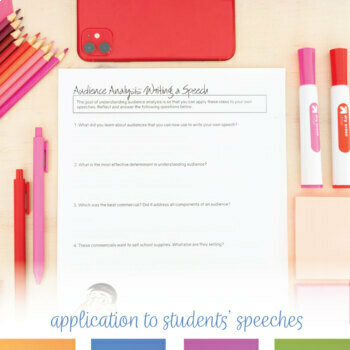Teaching Audience Analysis with Commercials
- Zip
What educators are saying
Description
Students must analyze their audiences before giving a speech or writing a paper. This presentation and subsequent activities will walk students through audience analysis by watching commercials.
Included in this audience analysis activity:
✓ Powerpoint: covers the definition and components of audiences; examines audiences; includes four (clean, school-appropriate) commercials links.
✓ Questions: includes analysis of each commercial through by looking at the target audience and the commercial's effectiveness in doing so.
✓ Culminating questions (can be done alone or in groups): ask students to evaluate and judge commercials regarding their reach to their target audience.
✓ Two different activities to apply the knowledge of audience to their speaking and writing. The graphic organizer includes a sample for students to experience what audiences may or may not understand.
✓ A handout of the questions.
Suggestions for use, detailed answer keys, and speaker notes are included. This lesson plan for audience analysis works well for both speech and writing courses.
I have coached a speech team for four years as well as taught a public speaking class for seven years. I have used commercials to show students that speakers/ advertisers have target audiences, and therefore deliver effective presentations.
This audience analysis activity is included in my Public Speaking Unit.
Do you need more public speaking activities?
• Teaching Ethos, Pathos, and Logos with Commercials
• Prized Possession & Favorite Person Speech Assignments
• Using a Visual Aid in Public Speaking: Best Practices for Speeches
~~~~~~~~~~~~~~~~~~~~~~~~~~~~~~~~~~~~~~~~~~~~~~~~~~~~~~~~~~
A Couple Tips:
* Be sure to click the "follow" button that is located next to my picture so that you can hear about sales, updated products, and new activities.
* By providing feedback on your purchased products, you can earn points, which ultimately translate into cash toward future purchases.
Feedback from other teachers about this audience analysis activity:
We used this in my public speaking class and my kids had a blast with it!
A fun and engaging lesson. Thanks for providing!
Fun activity that kept the engagement high





